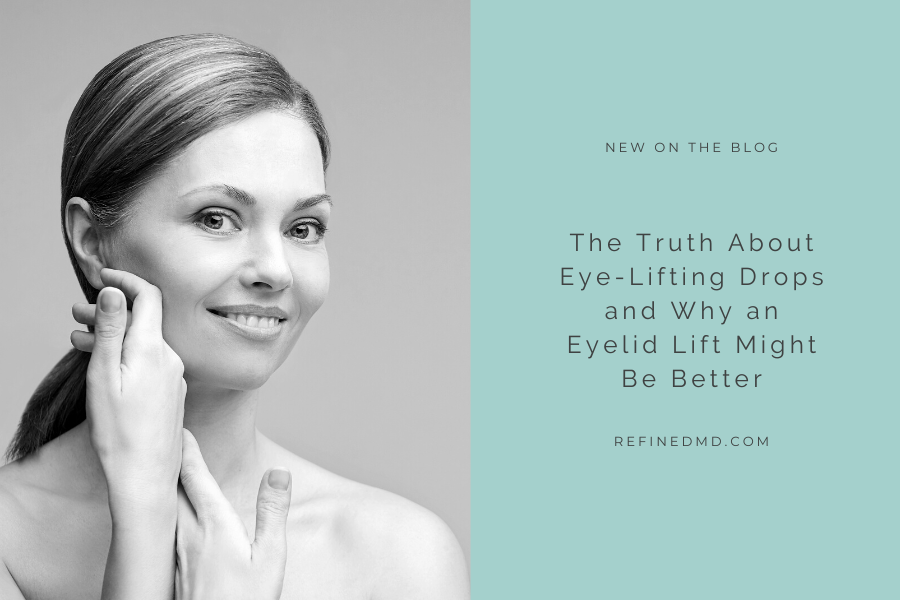
27 Dec The Truth About Eye-Lifting Drops and Why an Eyelid Lift Might Be Better
You’ve probably seen “eyelid lifting drops” with shocking before and after photos. However, at RefinedMD, we are committed to educating and informing clients on the latest techniques, trends, and procedures so that you can make the right decision for you and your aesthetic goals. One of the most well-known drops is Upneeq, only available by prescription—but does it really give you the results you want?
Before even considering trying such drops or more invasive procedures like eyelid lift surgery, the first step is figuring out what your concerns are about your eye area. Is it droopiness and, if so, where? This is important because the skin around the eyes can droop on the upper lid, lower lid, or both. Bear in mind that drops like Upneeq only address drooping on the upper lid and only for a short period. Specifically, Upneeq is prescribed to treat “blepharoptosis,” which is a condition where the upper eye sags. However, if you’re more concerned about your lower lids, dark circles, and bags, Upneeq and other drops aren’t going to do anything for you. Instead, for real results you’re better off with an eyelid lift, perhaps light liposuction in the lower lid area if there is a fat pocket, and/or dermal fillers in this area.
What’s Up with Upneeq?
Upneeq has earned the nickname “nonsurgical eyelid lift,” but that isn’t quite right. It offers short-term results that won’t last all day. However, it does work to some degree—Upneeq kickstarts the receptors located in the upper eyelid muscles, otherwise known as the Müller’s muscle. This lifts the eyelid because it’s oftentimes this muscle that is worn out and not elevating as it should. However, do bear in mind that prescriptions like this are only going to be effective if drooping is indeed caused by a tired muscle. If it’s mostly excess skin that’s the problem, which happens to everyone with age, stimulating those muscles aren’t going to make a difference.
The ideal candidate for Upneeq is someone who has “acquired ptosis,” which means it has happened over time or was caused by botched surgeries like Lasik or some other conditions such as nerve damage or a stroke. In some cases, when someone doesn’t go to a qualified injector for their Botox, Upneeq can be a great way to reverse Botox gone bad (which is your reminder to only trust reputable injectors for your Botox and other injectables—otherwise you might get stuck with unwanted results for a few months!).
The Saggy Eye Challenge
The makers and prescribers of Upneeq stress that these drops are only suitable for certain people with specific ptosis conditions. If a person is born with naturally severe drooping lids, Upneeq won’t be effective—in these cases, blepharoplasty (eyelid lifts) are a must. For those who do use Upneeq, it requires a daily regimen, albeit a quick one. One drop is placed in each eye, just like with any other eyedrop, and then you put light pressure on the inner eye corner to ensure the drops stay put. Blinking afterward helps to spread the drops around and avoid tears.
Upneeq does work quickly. Within 15 minutes, suitable candidates often see a vast improvement in droopiness. There are few serious side effects associated with Upneeq, and the desired results only last 6 – 10 hours on average. Unfortunately, prescriptions are only for one drop per eye per day, which means Upneeq isn’t going to take you from morning to evening. Users need to decide if they want to look younger, happier, healthier, and more alert either in the morning or evening, which is frustrating for most people with full schedules who want to look and feel their best all day. Some users also report watery eyes for the first few minutes after application as well as redness, itching, and burning in some cases.
A Better Solution
Although Upneeq is thus far deemed safe, there are some with conditions like heart problems, glaucoma, high blood pressure, and more who should see their GP before starting Upneeq. In addition to the short-term effectiveness and small but considerable side effects, there’s also the cost. The exact price will depend on the provider, but typically ranges from $170 – $230 per month—that’s up to $2,760 per year for results that only last a few hours per day.
If you’re serious about wanting to undo droopy lids, blepharoplasty is a much better option for most people. Eyelid surgery is available for the top lids, bottom lids, or both and provides results that last for years. Also, the downtime is surprisingly quick because the area around the eyes has such good blood flow. You will experience redness, swelling, and bruising for the first couple of weeks, but by week three most people feel confident to continue their life like it was pre-surgery (just with a lot more confidence). If you’d like to learn more about blepharoplasty at RefinedMD, call the office or fill out the online form now to schedule a consultation.
